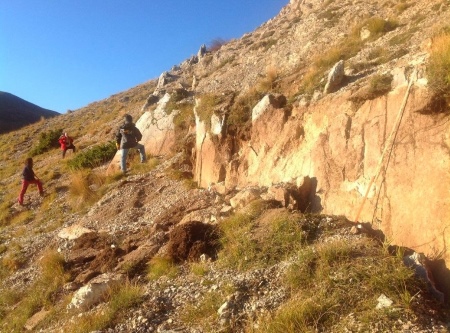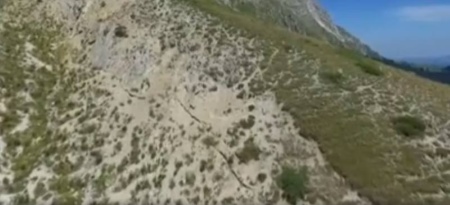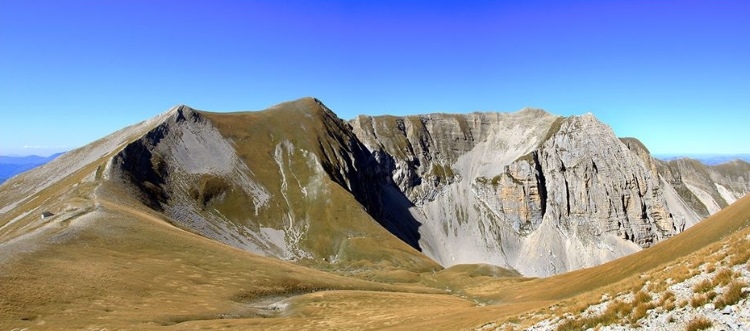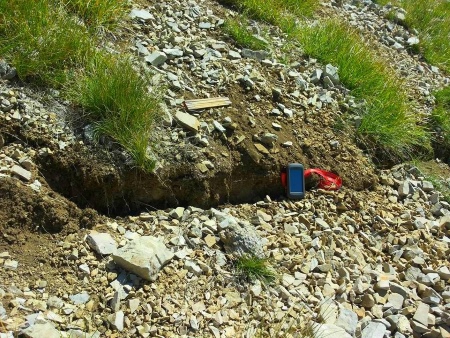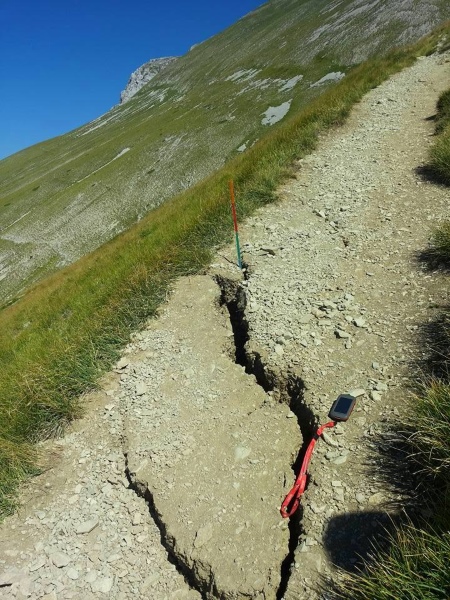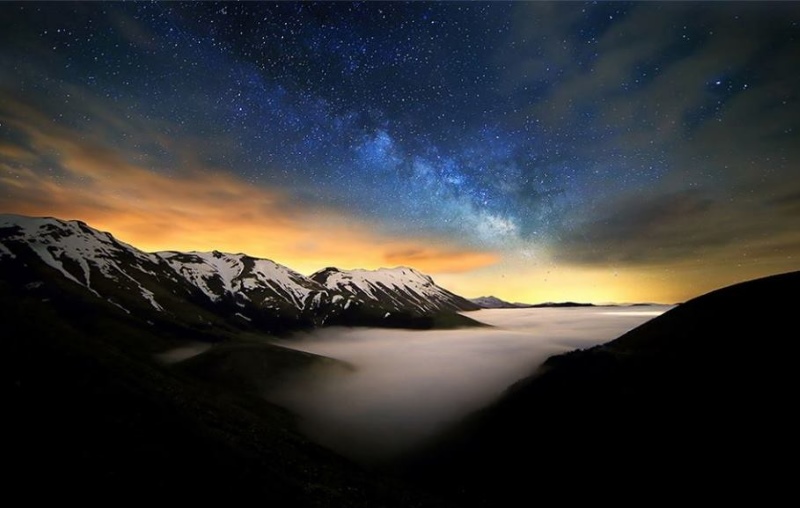10 Aug 2017
Earthquakes in the Sibillini Range: fault lines and chasms in 1703 (an unpublished quote)
In 2016 we have seen the peaks of the Sibillini Range open up and crack, a frightening token of the hidden subterranean strain.
However, this is no news at all: it has happened already, contributing to the magical fame of this remote, awe-inspiring place.
The following words written by Domenico Guglielmini in 1705 (subsequently published in Guillaume Desnoues' “Letters” in 1706) refer to the territory of Norcia just after the 1703 earthquake (6.7 Richter estimated). The ancient text and accompanying figure have never been published before this post:
«Here are other occurrences that are not abnormal (extraordinary as they may seem), and have been ascertained by the same Architect [Francesco Antonio Bufalini, who carried out the reconstruction works in Norcia by the orders of the Pope after 1703].
What happened twenty miles from Norcia may stir in Philosophers the most curious and fascinating thoughts. We must consider that the mountains, as you can see in the second figure I submit to you, opened themselves up across a span of twenty Italian miles, for a width of more than two yards; and a great portion of the mountain has collapsed for a diameter of forty-eight yards, with a circumference of a hundred and thirty yards, and so deep that up to now, by the use of a rope of a hundred and fifty yards, at the far end of which the Governor of Norcia Monsignor De Carolis had secured a cannonball, it was impossible to reach the bottom.
Now the matter is how to get to know what happened to that portion of the mount that has collapsed, and what is the origin of the shallow lake, filled with ordinary water, which popped up at the same time at the foot of the mountain, with a circumference nearly equal to that of the collapsed spot. The collapsed breach in the mount seems to be cut in sheer rock; apart from its hair-raising effect on the bystanders, if you throw some large stone into it then an utterly terrifying noise is produced, and it lasts for so long a time that the noise ends up in a sort of flurry and hissing of air».
This is the nature of the Sibillini Range: living mountains, who breathe in their sleep for centuries, until they wake up and shake men with all their might, leaving deep scars on their own body.
I Sibillini e i terremoti: faglie e voragini nel 1703 (una testimonianza inedita)
Nel 2016 abbiamo potuto vedere i picchi dei Monti Sibillini fessurarsi ed aprirsi, un segno spaventevole delle nascoste forze sotterranee.
Eppure, non si tratta affatto di una novità: tutto ciò è già accaduto, contribuendo a diffondere la fama magica e terribile di questi luoghi così remoti e suggestivi.
Le parole che seguono furono scritte da Domenico Guglielmini nel 1705 (in seguito pubblicate nel volume "Letters" di Guillaume Desnues nel 1706), si riferiscono al territorio di Norcia subito dopo il terremoto del 1703 (stimato al 6.7 Richter). Il testo e la figura dell'epoca non sono mai stati pubblicati prima di questo post:
«Ciò che è successo a venti miglia da Norcia può dare occasione ai Filosofi di fare delle belle e curiose riflessioni. Dobbiamo considerare che le montagne, delle quali potete vedere il diagramma nella seconda tavola, si sono aperte lungo tutta un'estensione di venti miglia italiane, e per la larghezza di un braccio e mezzo all'incirca; e che una grande porzione della montagna è collassata, della grandezza di ventiquattro tese [circa 50 metri] di diametro e di sessantacinque [circa 130 metri] di circonferenza, e di una profondità così considerevole che fino ad oggi, con ben 294 braccia [quasi 600 metri] di corda, all'estremo della quale il Governatore di Norcia Monsignor de Carolis aveva fatto attaccare una palla di cannone, è risultato impossibile raggiungerne il fondo.
Si tratta dunque di capire cosa sia avvenuto di questa parte della Montagna che si è inabissata; e da dove venga quel lago poco profondo, e pieno di un'acqua ordinaria, che si è formato allo stesso tempo ai piedi di questa montagna, e la cui circonferenza è all'incirca la stessa dell'apertura dell'area collassata.
L'imboccatura di questa montagna nella parte inabissatasi è quasi tutta come se fosse intagliata nella roccia; e oltre al fatto che la visione di essa fa rizzare i capelli in capo a chi la osservi, se vi si getta qualche grossa pietra, il rumore che ne vien fuori è supremamente terribile: e dura così a lungo, che esso non finisce se non con una specie di turbinìo e sibilo d'aria».
È questa la natura dei Monti Sibillini: montagne viventi, che respirano immerse nel sonno per secoli, per poi risvegliarsi e scuotere gli uomini con tutta la propria potenza, lasciando cicatrici profonde nel proprio stesso corpo.




21 Jan 2017
Legends arise where the presence of the gods is strong
Men have always looked at the Sibillini Range with awe, due to their savage beauty and impressive elevation. A place inhabited by unknown Gods. The mighty power of deities has revealed itself once more: the large fracture running across Mount Vettore - and visible from the Great Plain mid-height on the versant - is the border between two dislodging portions of Earth's crust, moving apart throughout immemorable ages.
It's the place where two conflicting gods are fighting each other. And their war is earthquake. A new scar in their gigantic bodies of stone is now visible. And men still look at the mountain with terrified, awe-stricken soul.
Le leggende nascono nei luoghi dove è forte la presenza delle divinità
Gli uomini hanno sempre considerato il massiccio dei Monti Sibillini con timore, a causa della loro bellezza selvaggia e per la spaventosa elevazione dei picchi. Un posto abitato da divinità sconosciute. Il potere titanico di queste divinità si è rivelato oggi ancora una volta: la gigantesca frattura che corre attraverso il Monte Vettore - visibile dal Pian Grande a metà altezza sul versante della montagna - è il confine tra due porzioni in scorrimento della crosta terrestre, che si stanno allontanando sin da epoche immemorabili.
È il posto dove si scontrano due divinità in lotta. E la loro guerra è il terremoto. Una nuova ferita è ora visibile nei loro giganteschi corpi di pietra. E gli uomini guardano di nuovo a queste montagne con atterrito terrore.
25 Nov 2016
Charles Darwin and a chronicle on earthquakes
When years ago I happened to read this excerpt from Charles Darwin's “A Naturalist's Voyage Round the World” with an account of the February, 20th 1835 ruinous earthquake in Valdivia, I was both struck and sceptical. Now I found that the very same occurrences just happened on our Sibillini Range and in New Zealand a few days ago:
«This day has been memorable in the annals of Valdivia, for the most severe earthquake experienced by the oldest inhabitant. I happened to be on shore, and was lying down in the wood to rest myself. It came on suddenly, and lasted two minutes, but the time appeared much longer. The rocking of the ground was very sensible. The undulations appeared to my companion and myself to come from due east, whilst others thought they proceeded from south-west. […] A bad earthquake at once destroys our oldest associations: the earth, the very emblem of solidity, has moved beneath our feet like a thin crust over a fluid;—one second of time has created in the mind a strange idea of insecurity, which hours of reflection would not have produced. […] The most remarkable effect of this earthquake was the permanent elevation of the land; it would probably be far more correct to speak of it as the cause. There can be no doubt that the land round the Bay of Concepcion was upraised two or three feet; [...] at the island of S. Maria (about thirty miles distant) the elevation was greater; on one part, Captain Fitz Roy found beds of putrid mussel-shells still adhering to the rocks, ten feet above high-water mark: the inhabitants had formerly dived at lower-water spring-tides for these shells.»
Charles Darwin e un resoconto sui terremoti
Quando anni fa mi imbattei in questo brano tratto dal “Viaggio di un naturalista intorno al mondo” di Charles Darwin, contenente il resoconto del rovinoso terremoto avvenuto il 20 febbraio 1835 a Valdivia (Cile), ne rimasi al contempo colpito e sconcertato. Oggi ho potuto riscontrare come i medesimi fatti abbiano avuto luogo nei nostri Monti Sibillini e anche in Nuova Zelanda alcune settimane fa:
«Questa giornata è stata memorabile negli annali di Valdivia, a causa del più forte terremoto che sia stato vissuto dai suo abitanti più anziani. Mi trovavo per caso sulla spiaggia, e mi ero disteso nel bosco per riposare un poco. Accadde tutto all'improvviso, e durò due minuti, anche se il tempo sembrò estremamente più lungo. Lo scuotimento della terra era molto percepibile. Le onde sembravano, a me e al mio accompagnatore, provenire da est, mentre ad altri parve che provenissero da sud-ovest […] Un brutto terremoto distrugge in un attimo le nostre più ferme convinzioni: la terra, vero emblema di solidità, si è messa sotto i nostri piedi come una sottile crosta su di un fluido; - un secondo di tempo è stato sufficiente per creare in noi una strana idea di insicurezza, che ore di riflessione non avrebbero mai potuto generare. […] Il più significativo effetto di questo terremoto è stato il sollevamento permanente del terreno; forse sarebbe molto più corretto descriverlo come la causa. Non ci può essere dubbio del fatto che la terra attorno alla Baia di Concepcion si sia innalzata di quasi un metro; […] all'isola di S. Maria (a circa trenta miglia di distanza), il sollevamento è stato ancora più rilevante; in uno specifico luogo, il Capitano FitzRoy ha trovato strati di conchiglie con molluschi in putrefazione ancora attaccate alla roccia, ben tre metri al di sopra della linea dell'alta marea: in precedenza, gli abitanti erano soliti tuffarsi nelle acque di bassa marea per raccogliere queste conchiglie.»

![]()
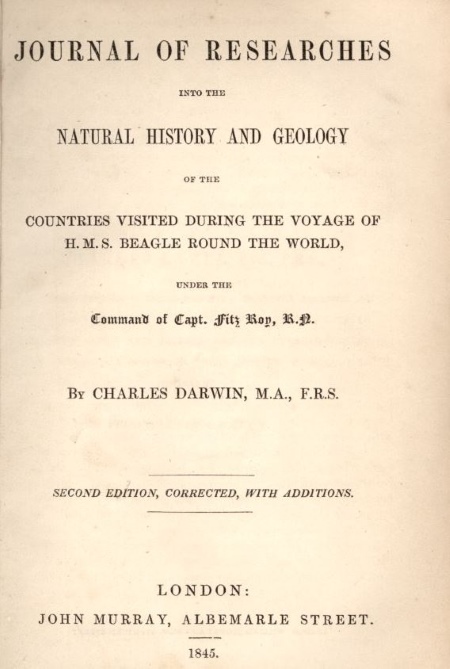

![]()


23 Nov 2016
A terrific thrust from below
Mount Vettore, 30th Oct 2016 earthquake - A five-feet-high layer of rock that had been concealed beneath the mountain-side for hundreds of thousands of years is now exposed to the view of awe-stricken humans. The might of the subterranean forces is so formidable it can displace a whole mountain.
Una potenza terrificante dal sottosuolo
Monte Vettore, terremoto del 30 ottobre 2016 – Uno strato di roccia alto quasi due metri, che era rimasto sepolto al di sotto del versante della montagna per migliaia di anni, è ora esposto alla vista degli uomini. La potenza delle forze sotterranee è così formidabile da spostare intere montagne.
2 Nov 2016
The ground displaced by the subterranean forces
The unbelievable happens. Following the October 30th 2016 ruinous earthquake, the road leading down from Mount Vettore (Forca di Presta) to Arquata and Montegallo has suffered heavy damages.
Only one year ago, on the same stretch of road the famous Italian singers Claudio Baglioni and Gianni Morandi filmed a scene of their music video for the song "Captains Courageous" (Capitani Coraggiosi).
Il suolo spostato dalle forze sotterranee
L'incredibile accade. Dopo il rovinoso terremoto del 30 ottobre 2016, la strada che conduce dal Monte Vettore (valico di Forca di Presta) ad Arquata e Montegallo ha subìto pesanti danneggiamenti.
Solamente un anno fa, proprio sullo stesso tratto di strada i noti cantanti italiani Claudio Baglioni e Gianni Morandi avevano girato una scena del loro video "Capitani Coraggiosi".
1 Nov 2016
The Sibillini Range and the earthquakes
Another view of the impressive scar created by the earthquake across the versant of Mount Vettore.
Top: the mountain before the earthquake (no fault lines to be seen on the grasslands)
Bottom: the mountain after the earthquake, with a fresh, titanic crack running across the mountain-side.
Il massiccio dei Monti Sibillini e i terremoti
Un'ulteriore vista dell'impressionante cicatrice creata dal terremoto sul versante del Monte Vettore.
Immagine superiore: la montagna prima del terremoto (non sono visibili fratture sul pendio erboso).
Immagine inferiore: la montagna dopo il terremoto, con una nuova e titanica frattura che corre lungo il versante.
1 Nov 2016
Mount Vettore, the fractured mountain /2
A close fly-by over the largest mountain in the Sibillini Range. On its western mountain-side, huge cracks have been carved by the October, 30th 2016 earthquake.
Monte Vettore, la montagna fratturata /2
In volo radente lungo la più grande montagna dei Monti Sibillini: sul versante occidentale, il terremoto del 30 ottobre 2016 ha creato gigantesche fratture.
31 Oct 2016
Mount Vettore, the fractured mountain
The gigantic crack that splits the western versant of Mount Vettore, along the southern portion across the Eagle's Cliff. The cleft then heads north across the whole mountain-side (where it wasn't there prior to the earthquake).
Monte Vettore, la montagna fratturata
La titanica frattura che percorre il versante occidentale del Monte vettore, lungo la parte meridionale in prossimità dello Scoglio dell'Aquila. La spaccatura si dirige verso nord attraverso tutto il versante della montagna, dopo essersi prodotta a valle del terremoto del 30 otttobre 2016.
8 Sep 2016
The underground potency of the earthquake
The impressive might of the October, 30th 2016 earthquake as filmed from a versant of the Sibillini Mountains.
La potenza sotterranea del terremoto
L'impressionante scossa di terremoto del 30 ottobre 2016, filmata da uno dei versanti dei Monti Sibillini.
8 Sep 2016
The hidden and mysterious life of the Sibillini
The more I live the earthquake experience, the more I sense and understand the magical nature of the Sibillini Mountain Range.
They are not a mere natural landscape, charming as it may be. They are not just heaps of rocks and grasslands. Men in antiquity have sure been striken by feelings of sheer terror at the sight of Mount Vettore, Mount Sibyl, the Lake of Pilatus.
The peaks and versants and waters were not dead things: they were alive. Awe-stricken men were able to feel their mighty breath, the vibration of their giant, rocky limbs, as seismic waves went across the region (earthquakes are always frequently perceived, throughout the year, as I myself can attest).
And - from time to time - the titanic deity of the Sibillini Range awoke and struck men with his godlike strength. Bringing to mortals destruction and death.
Here is the reason for the Sibillini to harbour a magical lore so deep and unyielding, throughout uncounted centuries. The reason for their unceasing spell. A spell which tells a tale of men and gods. An eternal tale of life and death.
La misteriosa vita nascosta dei Sibillini
Più faccio esperienza vera, diretta del terremoto, più mi sembra di comprendere e di sentire a fondo tutta la realtà della magica natura dei Monti Sibillini.
Queste montagne non costituiscono solamente un meraviglioso paesaggio naturale, per quanto incredibilmente affascinante. Non si tratta solamente di picchi rocciosi e pendii erbosi. Gli uomini, nell'antichità, sono stati certamente colti da sentimenti di puro terrore, alla vista di luoghi come il Monte Vettore, il Monte Sibilla, i Laghi di Pilato.
I picchi e i versanti e le acque, infatti, non erano oggetti immoti: essi erano vivi. Gli uomini terrorizzati potevano sentirne il respito possente, la vibrazione delle titaniche membra di roccia, mentre le onde sismiche spazzavano la regione (i terremoti sono frequentemente percepibili, durante tutto l'anno, come io stesso posso testimoniare).
E – di tanto in tanto – la divinità immensa dei Monti Sibillini si risvegliava e colpiva gli uomini con la propria forza immortale. Portando agli uomini morte e distruzione.
È questa la ragione per la quale i Sibillini ospitano nel loro seno un patrimonio di leggende così profondamente radicato, che ha attraversato innumerevoli secoli. È questa la causa da porsi alla base del loro fascino senza fine. Un fascino che narra un racconto spaventoso di uomini e dèi. Un racconto eterno di vita e di morte.
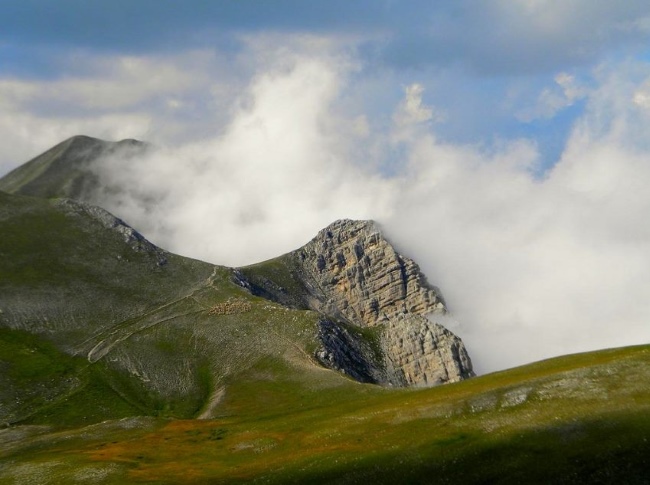

8 Sep 2016
An earthquake in the Sibillini Range
Silence was around me, quiet and thick, when the earthquake came. It came unforeseen, with a sudden, reckless step and got hurriedly into our room, unlocking no door, opening no windows, asking for no license.
Now, the silent bedroom was abruptly engulfed with an appalling uproar, surging from every corner, like the noise of a fast-approaching truck engine heading our way. When I fully awoke, it was already there. All was shaking and trembling and jolting as if by the killing hands of a madman, invisible as it was and yet unequivocally there, with its fiendish body and wickedness.
In the dim moonlight creeping through the window, in the unbearable uproar of the giant deity who wanted to snatch our souls, I looked up at the ceiling: it was sticking to its position, unmoved, unblemished.
And I knew we would save our lives.
Un terremoto nei Monti Sibillini
Solo silenzio attorno a me, denso e immoto, quando il terremoto arrivò. Giunse senza alcun preavviso, con passo improvviso, impetuoso, entrando in fretta nelle nostre stanze, senza aprire serrature, senza attraversare finestre, senza chiedere alcun permesso.
Adesso, la stanza - in precedenza silenziosa - si era riempita improvvisamente di un frastuono assordante, che prorompeva da ogni angolo, come il rumore di un gigantesco camion in rapido avvicinamento, diretto verso di noi. Quando riuscii a svegliarmi del tutto, esso era già lì. Tutto oscillava e tremava e veniva scosso come se fosse stretto tra le mani assassine di un uomo insano, benché del tutto invisibile – eppure esso era lì, presente, senza alcuna possibilità di errore, con tutta la sua essenza malvagia e demoniaca.
Nella pallida luce lunare, che filtrava attraverso i vetri, nell'insopportabile fragore della titanica divinità che voleva strapparci l'anima, guardai in alto verso il soffitto: resisteva coraggiosamente nella propria posizione, senza rompersi, senza fratturarsi.
E fu allora che seppi che ci saremmo salvati.
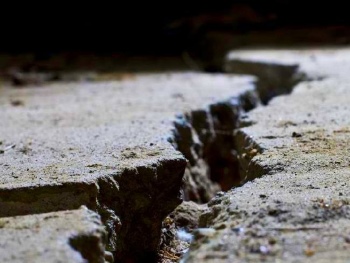

4 Sep 2016
Lake of Pilatus - The earthquake and the reason for a legend
Now that a lethal earthquake has striken the Sibillini Range area, can ancient legends be of any use to us?
Now perhaps the blind wrath of nature has provided us with a better understanding of the eerie words we find in many old tales about the Lake of Pilatus. In 1497, Arnolf of Harff wrote that each time necromancers ventured themselves up to the lake «and summoning was effected, the waters in the lake rose frenzily in a cloud and then came down again with an uproar as loud as thunder».
Now we can understand the meaning of those puzzling words: strange foreigners used to show up in Norcia, coming from abroad, bringing with them queer tools and books; they asked for local guides to lead them up to the Lake; then, they left Norcia and disappeared along the mountain trails. And - just in that exact time - the earthquake rumbled underneath, more than once, and sometimes with titanic power.
For local people, the uproars just came from the Lake of Pilatus and the strange rituals being performed by its shore. The earthquake - so frequent in the area, so scaring, often so destructive for the dilapidated hovels of the peasants - was the sign of something evil and fiendish that was being awakened by the strangers. And that is the reason for local authorities to decide to have the way to the Lake sealed, and necromancy forbidden.
Laghi di Pilato - Il terremoto e le ragioni di una leggenda
Ora che un mortale terremoto ha colpito la zona dei Monti Sibillini, quale insegnamento possiamo trarre dalle antiche leggende?
Ora, forse, la violenza cieca della natura ci ha fornito una spiegazione maggiormente evidente di tutte le parole sinistre, spaventose che è possibile rinvenire in molti antichi resoconti letterari sui Laghi di Pilato. Nel 1497, Arnolfo di Harff scrisse che ogni volta che i negromanti si spingevano su fino al lago, «e le evocazioni venivano effettuate, le acque del lago si innalzavano in furiosi vapori, per poi ricadere nuovamente con un rombo come di tuono».
Ora possiamo apprezzare il significato di queste enigmatiche parole: strani visitatori si presentavano un tempo a Norcia, di tanto in tanto; essi provenivano da contrade lontane, e portavano con loro strani libri e oggetti inusitati; chiedevano ai locali di essere guidati fino al lago; poi, abbandonata Norcia, sparivano lungo i sentieri di montagna. E – proprio allora – il terremoto rumoreggiava al di sotto della terra, più di una volta, e talvolta con potenza titanica.
Per la gente del luogo, i ruggiti della terra sembravano provenire proprio dai Laghi di Pilato, e parevano essere causati dagli strani rituali che venivano praticati su quelle rive. Il terremoto – così frequente nella zona, così spaventevole, spesso così distruttivo per i poveri ricoveri dei contadini – era dunque il segno di qualcosa di malvagio e demoniaco che veniva risvegliato dagli stranieri. Ed è per questo motivo che le autorità locali decisero di impedire l'accesso al lago, proibendo la pratica della negromanzia.
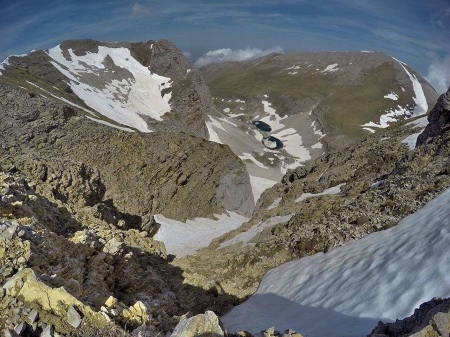

2 Sep 2016
The beast beneath the ground
The beast beneath the ground: the ghastly crack running across the mountain-slope of Mount Vettore, a token of the the titanic force splitting apart the two sides of the peak and of Italy itself.
In this place the sinister mystery of an unknown subtearranean thrust can be seen by human eyes, contributing to the eerie fame that the Sibilini Range in Italy has gained throughout uncounted centuries.
La belva sotto la terra
La belva nel sottosuolo: la spaventosa frattura che corre lungo il versante occidentale del Monte Vettore, un segno delle forze titaniche che stanno spezzando i due lati della montagna e dell'intera Italia.
In questi luoghi, l'occhio umano è in grado di percepire il mistero sinistro di una potenza sotterranea sconosciuta, contribundo così alla fama inquietante che i Monti Sibillini si sono conquistati nel corso di innumerevoli secoli.
31 Aug 2016
Sibillini, land of Gods
Men have always looked at the Sibillini Range with awe, due to their savage beauty and impressive elevation. A place inhabited by unknown Gods. The mighty power of deities has revealed itself once more: the large fracture running across Mount Vettore - and visible from the Great Plain mid-height on the versant - is the border between two dislodging portions of Earth's crust, moving apart throughout immemorable ages.
It's the place where two conflicting gods are fighting each other. And their war is earthquake. A new scar in their gigantic bodies of stone is now visible. And men still look at the mountain with terrified, awe-stricken soul.
Sibillini, terra di Dèi
Gli uomini hanno sempre considerato il massiccio dei Monti Sibillini con timore, a causa della loro bellezza selvaggia e per la spaventosa elevazione dei picchi. Un posto abitato da divinità sconosciute. Il potere titanico di queste divinità si è rivelato oggi ancora una volta: la gigantesca frattura che corre attraverso il Monte Vettore - visibile dal Pian Grande a metà altezza sul versante della montagna - è il confine tra due porzioni in scorrimento della crosta terrestre, che si stanno allontanando sin da epoche immemorabili.
È il posto dove si scontrano due divinità in lotta. E la loro guerra è il terremoto. Una nuova ferita è ora visibile nei loro giganteschi corpi di pietra. E gli uomini guardano di nuovo a queste montagne con atterrito terrore.
29 Aug 2016
A mighty power underneath
The furious nature of the subterranean forces that lifted the Sibillini Mountain Range from the primeval sea: the mountain-slopes near Castelluccio are broken and cracked. An inhuman, overpowering thrust who snatched three hundred lives in a matter of seconds. Let's pray for the people who died under the wreckage of their homes. Their life and dreams will not be lost completely: their beloved mountain towns and villages will come to life again, in the same locations and the same way they once were. Because earthquake is strong, yet human soul is much stronger.
Una titanica potenza sotterranea
La natura selvaggia delle forze sotterranee che hanno innalzato il massiccio dei Monti Sibillini dal mare primordiale: i versanti vicino Castelluccio sono oggi frantumati e fratturati. Una potenza smisurata ed inumana, che è stata capace di ghermire trecento vite umane in pochissimi secondi.
25 Aug 2016
Earthquake in the Sibyl's land
In the middle of the night, the ghastly and blood-curdling coming of the earthquake: a faceless intruder, who has crept unseen into your private, intimate rooms, passing through no door. He starts shaking your body, with merciless cruelty, with his cold, invisible hands, as your sudden scream is overpowered by his mighty, fiendish bellow. He craves for your life, he wants to take your soul away from you, in the savage collapse of your house and kindred. An utterly inhuman, abominable beast.
Terremoto nelle terre della Sibilla
Nel pieno della notte, l'arrivo agghiacciante, terrificante del terremoto: un visitatore privo di volto, che si è introdotto silenziosamente nella tua casa, nelle tue stanze, senza attraversare alcuna porta. Esso comincia a scuotere il tuo corpo, con crudeltà impietosa, con le sue fredde mani invisibili, mentre il tuo urlo improvviso si perde all'interno del suo possente ruggito di belva. Desidera la tua vita, vuole portare via la tua anima, nel crollo brutale della tua casa e del tuo nome. Una bestia inumana e abominevole.
15 Aug 2016
Mount Sibyl's divine radiance
Call of the Apennine Sibyl: the setting sun enshrouds the crowned peak of Mount Sibyl in radiant light, a token of the mysterious, divine nature of the place.
Divina radianza dal Monte Sibilla
Il richiamo della Sibilla Appenninica: il sole calante incornicia di luce radiante il picco coronato del Monte Sibilla, un segno della misteriosa, semidivina natura di questi luoghi.
7 Jun 2016
The reason for a legend
How can it be that a solitary peak in Italy has become the famed “Mount Sibyl”, the center of unbroken attention and centuries-long attempts at exploration?
Two main elements lie underneath the lasting success of Mount Sibyl.
The first one is its magnificent, amazing shape: a crowned mountain, its top encircled by steep walls of stone. A token of regality, a mark carved in sheer rock which signals the presence of a deity of nature and wildlands.
The second elements is the cavern: a dark gloomy hollow opening on a mountainous ridge. It's the entrance to a nether world, an access to the realm of the dead; nonetheless, it rests so close to the stars above that it shows an unquestionable kinship with the sun and the moon and the heavenly powers.
A regal castle and a divine presence. A gate to hell, a den of evil; and yet a trasnmitter for speaking to God.
No wonder men of all times have always been bewitched by that solitary, insignificant peak in the Sibillini Range.
Le ragioni di una leggenda
Come è potuto accadere che un remoto picco montano italiano sia divenuto il rinomato “Monte della Sibilla”, il centro di un'attenzione ininterrotta e di lunghi secoli di tentativi di esplorazione?
Due elementi principali si collocano alla base del duraturo richiamo che sembra provenire dal Monte Sibilla.
Il primo è la sua fantastica, incredibile forma, con la vetta circondata da ripide pareti di roccia. Un segno di regalità, un marchio intagliato nella roccia a precipizio che sembra segnalare la presenza di una divinità della natura selvaggia ed incontaminata.
Il secondo elemento è la presenza di una grotta: una cavità tenebrosa che si apre su di una cresta elevata. È l'ingresso ad un mondo infero, un accesso al regno dei morti, restando però al contempo così prossimo alle stelle del cielo da mostrare una incontrovertibile connessione con il sole, la luna e le potenze celesti.
Un castello regale e una divina presenza. Un accesso verso il mondo sotterraneo, covo di demoni; eppure, anche una trasmittente per parlare con Dio.
E dunque, non c'è da meravigliarsi se gli uomini di ogni epoca abbiano sempre subìto il fascino di questo picco solitario ed insignificante, sperduto all'interno del massiccio dei Monti Sibillini.


24 Mag 2016
Cosmic visions
A cosmic vision of the Great Plain under a cold, starry night. Out of its isolated position, elevated slopes and eerie lore, the Sibillini Range appears to be a place where terrestrial and supernatural meet together, as the icy currents flooding down from deep space sweep the craggy crests with their shadowy fingers.
Visioni cosmiche
Una visione cosmica del Pian Grande di Castelluccio in una fredda notte stellata. A causa della sua posizione isolata, dei pendii erbosi in quota e delle sinistre leggende che lo abitano, il massiccio dei Monti Sibillini sembra essere un luogo dove il naturale e il soprannaturale si incontrano: le gelide correnti che provengono dallo spazio profondo sembrano infatti carezzare le creste rocciose con dita d'ombra.
1 Gen 2016
Magical vibrations in the landscape
Why is the Apennine Sibyl's mystery so resounding in our modern men's hearts? Because it is a mystery establishing a link between the human soul and universal life, and afterlife. The cave is where we were born from. The mountain peak is the place where we can set off from to reach the starry sky. In the myth of the Apennine Sibyl, the two elements - cave and peak - are so closely intertwined that the legendary tale is drenched with the notions of life (the cave) and death (the sky). The fact that the story is staged in a real place - where anyone of us can physically go and experience the potency of the tale: Mount Sibyl's peak in Italy - is an irresistible lure for people in search of truth, adventure, emotion.
Panorami dalle magiche vibrazioni
Perché il mistero della Sibilla Appenninica risuona così intensamente nei cuori degli uomini di oggi? Perché si tratta di un mistero che stabilisce una relazione tra l'animo umano, la vita del cosmo, e la vita oltre la morte. La caverna è simbolo del luogo dal quale tutti siamo nati. Il picco montuoso è il luogo dal quale possiamo inoltrarci verso il cielo abitato dalle stelle. Nel mito della Sibilla Appenninica, i due elementi – caverna e vetta – sono così intimamente connessi da rendere il racconto leggendario intriso dagli elementi della vita (la caverna) e della morte (il cielo stellato). Il fatto poi che la vicenda sia ambientata in un luogo realmente esistente – dove ognuno di noi può recarsi fisicamente per esperimentare di persona la potenza del racconto – costituisce un'attrazione irresistibile per chi si trovi in cerca di verità, avventura ed emozione.
15 Dic 2015
The Romans and the Sibilini Range
In ancient Rome, the Sibillini Range was known as the region of "Mons Fiscellus" and the Sibyl's peak as the "Tetricus Mons". Authors such Marcus Terentius Varro, Pliny the Elder and Publius Vergilius Maro knew well these mountains and their rustic and mysterious appeal.
A trace of that vanished world can be found at the Vatican Museums, in the huge Gallery of Maps: on the map depicting the Sibillini region, the craggy nature of the "Fiscellus"chain can be observed. It's right there that the Sibyl's cave is to be found: a travel into mystery and fear, that enthralls the visitor even in our present times.
I Romani e i Monti Sibillini
Nell'antica Roma, il massiccio dei Monti Sibillini era conosciuto con il nome di “Mons Fiscellus” e il Monte Sibilla come “Tetricus Mons”. Autori come Marco Terenzio Varrone, Plinio il Vecchio e Publio Virgilio Marone conoscevano molto bene queste montagne e il loro fascino misterioso ed elusivo.
Una traccia di questo mondo scomparso può essere rinvenuta presso i Musei Vaticani, nella grande Galleria delle Carte Geografiche: sulla mappa che rappresenta la regione dei Sibillini, è possibile vedere rappresentata la natura selvaggia della catena del “Fiscellus”. È lì che è situata la Grotta della Sibilla: un viaggio nel mistero e nel soprannaturale, che ancor oggi incanta il visitatore.












